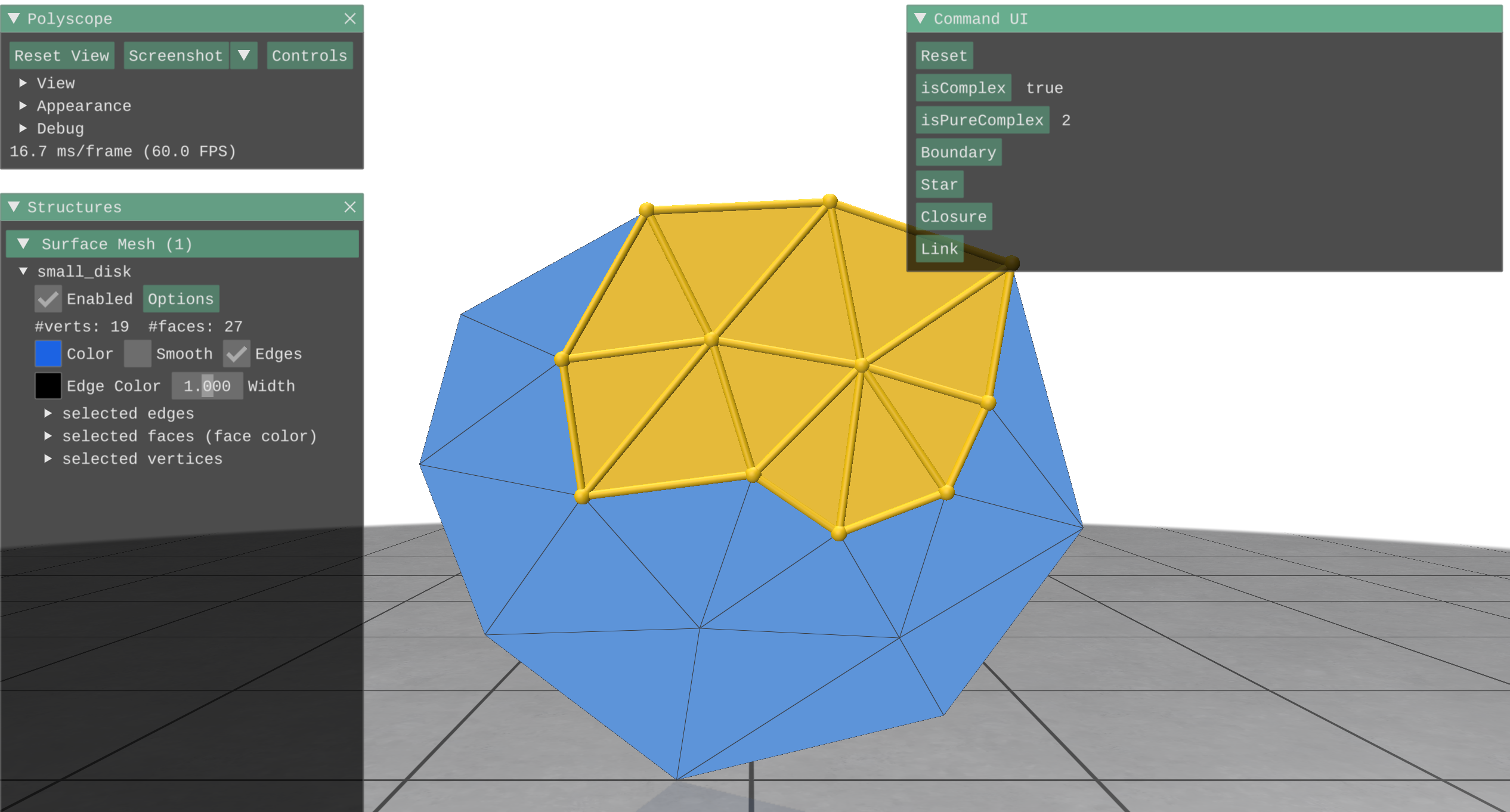Discrete Differential Geometry A0: Combinatorial Surface
Learn definitions and operations on meshes and manifolds.
Project
Written Assignment A0
Exercise 2.1
My proof sketch is to triangulate the original shape, then show the changes of V, E and F
Exercise 2.2
https://www.mathsisfun.com/geometry/platonic-solids-why-five.html
Suppose we have $s$ sides for each faces, $m=\text{val}(v_i)$ for each vertex, then we decompose the sphere, got:
\[sF=2E=mV\]Then we put the equation into Euler formula:
\[\frac{2E}{m}-E+\frac{2E}{S}=2\]Derive it:
\[\frac{1}{m}+\frac{1}{s}=\frac{1}{E}+\frac{1}{2}\]And we have $m \ge 3$, $s \ge 3, E \ge 6$, and valid solution for m, s pairs are $(3,3), (3,4), (3,5), (5,3), (4,3)$, Q.E.D.
Exercise 2.3
Proof Sketch is similar to the topology solution to ex 2.2
First we know $V-E+F=2-2g$, then we decompose the surfaces, then we got two extra constraints:
- For vertices, we have $\text{val}(v)=6$, so $6V=2E$
- For new edges, we got $e’F=2E$, since the surface is connected and orientable and finite, we could decompose it to a triangular mesh, then $e’=3$, so $3F=2E$
Putting together, we got $\frac{1}{3}E-E+\frac{2}{3}E=2-2g$, then $g=1$, so the only solution is a torus.
Exercise 2.4
https://yblin.is-programmer.com/posts/43217
Decompose vertices into $n$ irregular vertices and $V-n$ regular vertices, then we got:
\[2E=3F=6(V-n)+\sum_{i=1}^{n}val(v_i)\]Put it into Euler formula:
\[V-\frac{6(V-n)+\sum_{i=1}^{n}val(v_i)}{6}=2-2g\] \[n-\frac{1}{6}\sum_{i=1}^{n} val(v_i) = 2-2g\] \[n = \frac{1}{6}\sum_{i=1}^{n} val(v_i) + 2-2g\]Since $val(v_i)\ge3$:
\[n\geq2-2g+\frac{n}{2}\]So
\[n \geq 4-4g\]Case 1: $g=0$, then we got $n \geq 4$
Case 2: $g = 1$, then we got $n \geq 0$
Case 3: $g \geq 2$, we cannot use equation (9) anymore, when $n=0$ does not satisfy equation (7), and $n=1$ is a valid solution.
Exercise 2.5
We already have the equation
\[2E=3F=\sum val(v_i) = \frac{\sum val(v_i)}{V}V\]And now that $\frac{\sum val(vi)}{V} = 6$, Then $V:E:F=1:3:2$.
Exercise 2.6
Consider grid-like quad mesh, then $2E=4F$, and each vertex is connected to 4 faces, so $V:E:F=1:2:1$
Exercise 2.7
Consider the combination of icosahedrons, each face corresponds to 2 tets, so $2F=4T$. And In each icosahedrons, one vertex corresponds to 20 tets, and each tet correspond to 4 vertices, so $V:T=1:5$, Now we got $V:E:F:T=1:6:10:5$ due to the Euler formula.
Exercise 2.8
Star of edges are edges themselves and triangles that contains that edge (in 2D.
Star of triangles are themselves (in 2D).
$St(S)$:
Vertices: e, k, o
Edges: ea, eb, ef, ek, ej, ed, of, ol, oq, op, ok, kp, kj
Faces: aed, aeb, ebf, ekf, ejk, ejd, eda, ofl, ols, opq, oks, oks, jkp, njp
$Cl(S)$:
Vertices: e, f, o, k, j, p, n
Edges: jk, kp, jp, jn, np, of
Faces: jnp, jkp
$Lk(S)=Cl(St(S)) \backslash St(Cl(S)) $
Edges: ab, lq, ad
Vertices: a, b, d, l, q
(This should be verified with code… Too complicated)
Exercise 2.9
Bd(K)=abflmsqpjea
Int(K)=everything inside cl(K) besides bd(K), this is easy.
Exercise 2.10
Twin of 0-9: 4215037698
Next of 0-9: 1204563978
Exercise 2.11
Draw it on your paper :)
Exercise 2.12
For $A_0$, mark corresponding vertices to be 1 for each face, and do the same job for edges in $A_1$
Exercise 2.13
Explain Simplicity 1-manifold looks like a closed loop or path. (This is not a proof)
An important to mention is that a simplicial 0-sphere is a set of two points, since we have the definition:
\[\mathbb{S}^n:=\{x\in \mathbb R^{n+1} : |x|=1\}\]When n = 0, it reduced to ${-1,1}$
Branches are not allowed in the link of simplicial 1-manifold since it would lead to at least 3 points, which are not homeomorphic to 0-sphere.
So when we expand the link, it could not generate the higher dimensional simplifies like faces and tets. So we just got path and closed loops
Exercise 2.14
Proof sketch is the same. The link of a vertex in simplicial 2-manifold is homeomorphic to a circle, which looks like a closed loop. So we do not have the “suddenly ending” points(like y-forks, whose link is a 0-sphere)
Personally I cannot write a strict proof, but those two questions give me a feeling of a well defined simplicial k-manifold with links :)
Exercise 2.15
The explanation is based on the definition of boundary on simplicial k-manifold:
all (k−1)-simplices in K that are contained in exactly one k-simplex
And we cannot find a (k-2)-simplices in K that belongs to exactly one (k-1)-simplices.
(Take k=2 as an example, boundary of simplicial 2-manifold is the outside edges, but each vertex on the boundary belongs to 2 edges, so there is no boundary.)
There is a proof with a sequence definition of boundary maps: https://algebrology.github.io/simplicial-complexes-and-boundary-maps/
